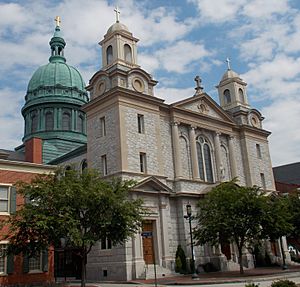Cathedral of Saint Patrick (Harrisburg, Pennsylvania) facts for kids
Quick facts for kids Cathedral of St. Patrick |
|
|---|---|
 |
|
| 40°15′49.32″N 76°53′11.04″W / 40.2637000°N 76.8864000°W | |
| Location | 212 State St. Harrisburg, Pennsylvania |
| Country | United States |
| Denomination | Roman Catholic |
| History | |
| Status | Cathedral/Parish |
| Dedication | Saint Patrick |
| Architecture | |
| Architect(s) | George I. Lovatt, Sr. |
| Style | Baroque Revival |
| Groundbreaking | 1904 |
| Completed | 1907 |
| Construction cost | $250,000 |
| Specifications | |
| Number of domes | One |
| Materials | Granite |
| Administration | |
| Diocese | Harrisburg |
The Cathedral of Saint Patrick is a very important Catholic Church building in downtown Harrisburg, Pennsylvania, United States. It is the main church for the Diocese of Harrisburg. This means it's where the bishop of the diocese has his special chair and leads services. The cathedral is also part of the Harrisburg Historic District, which is listed on the National Register of Historic Places.
Contents
History of St. Patrick's Cathedral
Catholicism arrived in Central Pennsylvania even before the American Revolutionary War. German Jesuits (a group of Catholic priests) built early chapels in the 1730s and 1740s. By 1806, there was a small Catholic group in Harrisburg.
Building the First Church
In 1813, land was bought in Allison Hill, Harrisburg, and a small chapel was built there. As Harrisburg grew, many Irish immigrants moved to the town. In 1824, a priest named Rev. Patrick Leary bought land on State Street. The first stone for the original St. Patrick's church was laid two years later, in 1826. This church cost $6,500 to build. A very important person, St. John Neumann, who was the bishop of Philadelphia at the time, visited the parish in 1855 and 1857.
Becoming a Cathedral
The Diocese of Harrisburg was officially created by Pope Pius IX on March 3, 1868. St. Patrick's church was then named the "pro-cathedral" of this new diocese. This meant it was the temporary main church.
In 1902, Bishop John W. Shanahan suggested building a permanent, grander cathedral. A group was formed to plan this. They chose the designs of an architect from Philadelphia named George I. Lovatt, Sr.. Before construction could begin, bodies buried in the old parish cemetery had to be moved to a new cemetery called Mount Calvary.
Ground was broken for the new cathedral in 1904. It was finished on March 1, 1907. The new cathedral cost $250,000 to build. In 1976, the church was officially added to the National Register of Historic Places as part of the Harrisburg Historic District.
Architecture and Design
St. Patrick's Cathedral was designed in a style called Baroque Revival. It also has influences from Renaissance Revival styles. The building has a beautiful dome on top.
Outside and Inside Features
The outside of the cathedral is covered in granite stone from North Carolina. Inside, the lower walls have wainscoting made of special oriental marble, topped with green Connemara marble. The main part of the church, called the nave, has tall granite columns. These columns hold up the vaulted ceiling.
There are forty-four amazing stained glass windows in the nave. These windows were brought all the way from Munich, Germany. The original altar (the table where religious services are held) was designed to look like a famous altar in St. Peter's Basilica in Rome. The original pulpit (where sermons are given) had carved figures that looked like an old painting found in the Roman Catacombs. These carvings showed the four evangelists (writers of the Gospels) with the Lamb of God.
Renovations and Changes
The cathedral has been updated a few times over the years. In 1949-1950, the altar was made simpler, and the chancel (the area around the altar) was changed to create more space. The inside walls and ceiling were painted with frescos (paintings done on wet plaster). These paintings include the four important Western Fathers of the Church: Jerome, Augustine of Hippo, Gregory the Great, and Ambrose. These figures decorate the curved parts beneath the dome. An important message was added to the lower part of the dome: "Behold, I am with you all days, even to the consummation of the world."
The shrines (special places of honor) for the Blessed Virgin Mary and Saint Joseph were given special backgrounds that made them look like old paintings. The Stations of the Cross (pictures showing events from Jesus' last day) were made to look like bronze with gold highlights and were placed into the walls.
In 1976, the chancel was changed again. A new altar was made from parts of the old one and moved closer to the people. The tabernacle (where the Eucharist is kept) was placed at a new Altar of Repose. A new ambo (another type of pulpit) was put in, and the cathedra (the bishop's special chair) was moved to a more central spot.
Shrines to Bishops
Over the years, several shrines were added inside the cathedral to remember the past bishops of Harrisburg. Bishop John W. Shanahan is honored with a bronze crucifix (a cross with Jesus on it) at the back of the cathedral. Bishop Philip R. McDevitt has a shrine showing Christ teaching children. Bishop George L. Leech is honored with a shrine of Saint Elizabeth Ann Seton. Bishop Joseph T. Daley has a shrine of Saint John Neumann. There is also a shrine to Saint Katherine Drexel in the cathedral's entrance area.
See also
 In Spanish: Catedral de San Patricio (Harrisburg) para niños
In Spanish: Catedral de San Patricio (Harrisburg) para niños




